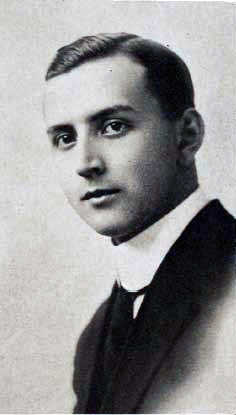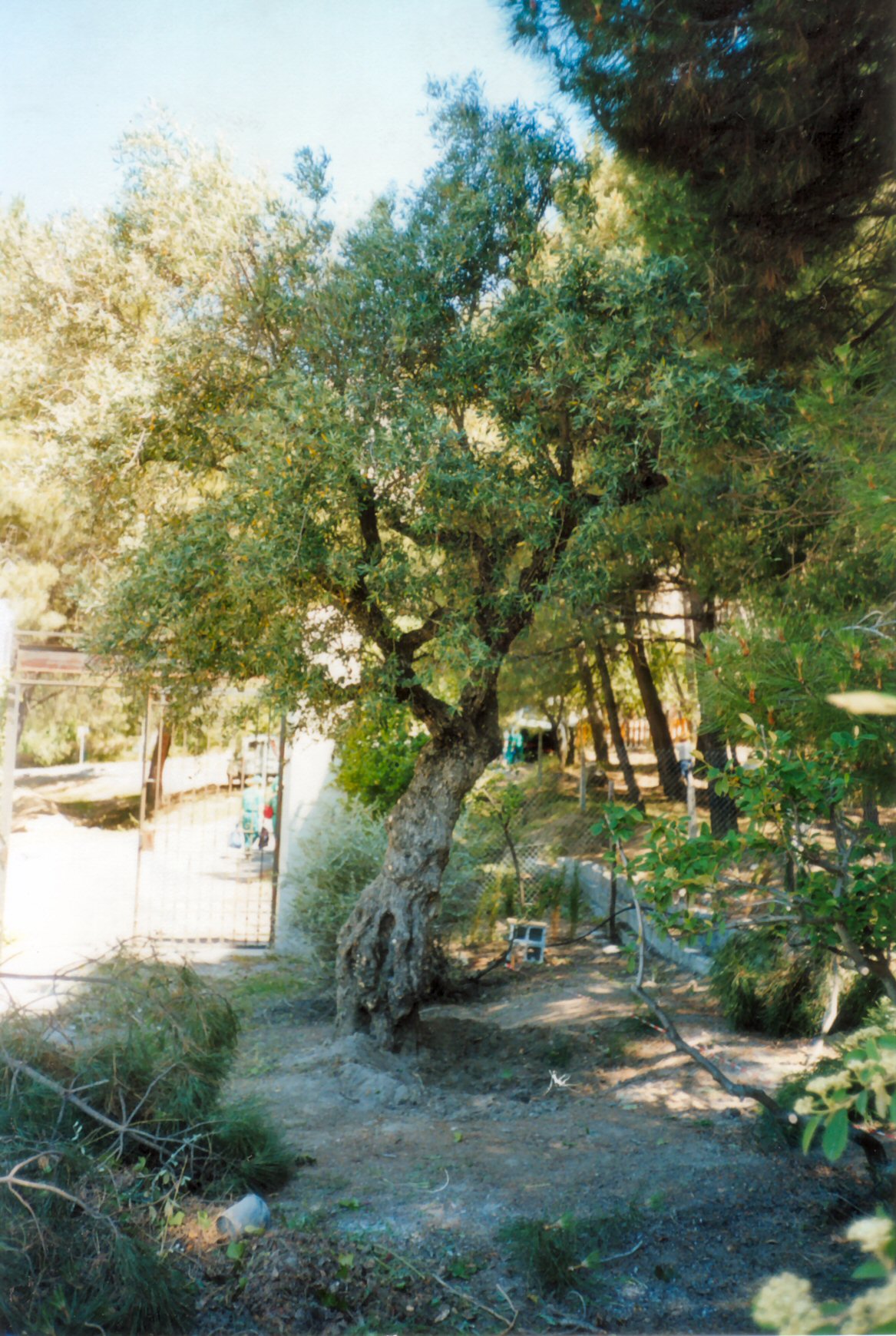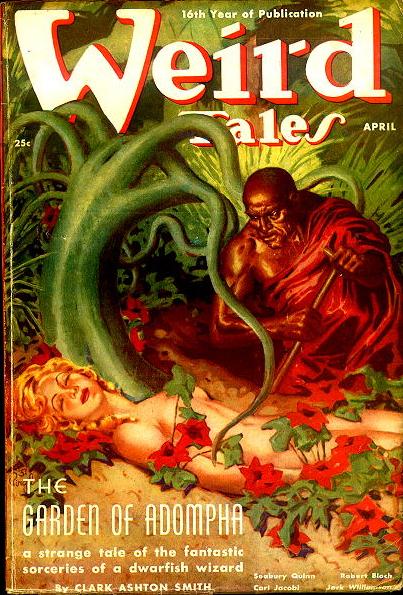|
The Black Abbot Of Puthuum
"The Black Abbot of Puthuum" is a short story by American author Clark Ashton Smith as part of his Zothique cycle, and first published in the March 1936 issue of ''Weird Tales''. Plot In Yoros, Zobal the archer and Cushara the pike-bearer are assigned by king Hoaraph to retrieve the maiden Rubalsa from Izdrel for the king's harem. They are accompanied by the eunuch Simban. While they retrieve Rubalsa and head off for Yoros, a darkness envelops them. Surrounded by darkness, strange sounds haunt them. Eventually they are met by a black man Ujuk, who is an abbot for the monastery Puthuum. Ujuk invites them to a feast, but Zobal and Cushara are skeptical of his intentions. Later that night, Zobal finds an animate mummy named Uldor. Uldor tells Zobal he was the last survivor of a monastery. However, in the final days, Uldor was visited by a lamia and they had a son, Ujuk. Uldor pleads with Zobal to kill Ujuk. Zobal does this and Puthuum disappears. Meanwhile, Sibman dies. Deciding this i ... [...More Info...] [...Related Items...] OR: [Wikipedia] [Google] [Baidu] |
Weird Tales
''Weird Tales'' is an American fantasy and horror fiction pulp magazine founded by J. C. Henneberger and J. M. Lansinger in late 1922. The first issue, dated March 1923, appeared on newsstands February 18. The first editor, Edwin Baird, printed early work by H. P. Lovecraft, Seabury Quinn, and Clark Ashton Smith, all of whom went on to be popular writers, but within a year, the magazine was in financial trouble. Henneberger sold his interest in the publisher, Rural Publishing Corporation, to Lansinger, and refinanced ''Weird Tales'', with Farnsworth Wright as the new editor. The first issue under Wright's control was dated November 1924. The magazine was more successful under Wright, and despite occasional financial setbacks, it prospered over the next 15 years. Under Wright's control, the magazine lived up to its subtitle, "The Unique Magazine", and published a wide range of unusual fiction. Lovecraft's Cthulhu mythos stories first appeared in ''Weird Tales'', starti ... [...More Info...] [...Related Items...] OR: [Wikipedia] [Google] [Baidu] |
Clark Ashton Smith
Clark Ashton Smith (January 13, 1893 – August 14, 1961) was an American writer and artist. He achieved early local recognition, largely through the enthusiasm of George Sterling, for traditional verse in the vein of Algernon Charles Swinburne, Swinburne. As a poet, Smith is grouped with the West Coast Romantics alongside Joaquin Miller, Sterling, and Nora May French and remembered as "The Last of the Great Romantics" and "The Bard of Auburn". Smith's work was praised by his contemporaries. H. P. Lovecraft stated that "in sheer daemonic strangeness and fertility of conception, Clark Ashton Smith is perhaps unexcelled", and Ray Bradbury said that Smith "filled my mind with incredible worlds, impossibly beautiful cities, and still more fantastic creatures". Smith was one of "the big three of ''Weird Tales'', with Robert E. Howard and H. P. Lovecraft", but some readers objected to his morbidness and violation of pulp traditions. The fantasy critic L. Sprague de Camp said of him th ... [...More Info...] [...Related Items...] OR: [Wikipedia] [Google] [Baidu] |
Zothique
''Zothique'' is a collection of fantasy short stories by Clark Ashton Smith, edited by Lin Carter. It was first published in paperback by Ballantine Books as the sixteenth volume of its Ballantine Adult Fantasy series in June 1970. It was the first themed collection of Smith's works assembled by Carter for the series. The stories were originally published in various fantasy magazines in the 1930s, notably ''Weird Tales''. Background The book collects one poem and all sixteen tales of the author's Zothique cycle, set on the Earth's last continent in a far distant future, with an introduction, map, and epilogue by Carter. They were originally written and published between 1932 and 1951. Most were written in a tar paper and wood cabin in Auburn, California. All were first published in the magazine ''Weird Tales'' with the exception of "The Voyage of King Euvoran" which first appeared in the 1933 book ''The Double Shadow and Other Fantasies'' and later republished under the title "The ... [...More Info...] [...Related Items...] OR: [Wikipedia] [Google] [Baidu] |
Fantasy
Fantasy is a genre of speculative fiction involving Magic (supernatural), magical elements, typically set in a fictional universe and sometimes inspired by mythology and folklore. Its roots are in oral traditions, which then became fantasy literature and drama. From the twentieth century, it has expanded further into various media, including film, television, graphic novels, manga, animations and video games. Fantasy is distinguished from the genres of science fiction and horror fiction, horror by the respective absence of scientific or macabre themes, although these genres overlap. In popular culture, the fantasy genre predominantly features settings that emulate Earth, but with a sense of otherness. In its broadest sense, however, fantasy consists of works by many writers, artists, filmmakers, and musicians from ancient mythology, myths and legends to many recent and popular works. Traits Most fantasy uses magic (paranormal), magic or other supernatural elements as a ma ... [...More Info...] [...Related Items...] OR: [Wikipedia] [Google] [Baidu] |
Pulp Magazine
Pulp magazines (also referred to as "the pulps") were inexpensive fiction magazines that were published from 1896 to the late 1950s. The term "pulp" derives from the cheap wood pulp paper on which the magazines were printed. In contrast, magazines printed on higher-quality paper were called "glossies" or "slicks". The typical pulp magazine had 128 pages; it was wide by high, and thick, with ragged, untrimmed edges. The pulps gave rise to the term pulp fiction in reference to run-of-the-mill, low-quality literature. Pulps were the successors to the penny dreadfuls, dime novels, and short-fiction magazines of the 19th century. Although many respected writers wrote for pulps, the magazines were best known for their lurid, exploitative, and sensational subject matter, even though this was but a small part of what existed in the pulps. Successors of pulps include paperback books, digest magazines, and men's adventure magazines. Modern superhero comic books are sometimes considere ... [...More Info...] [...Related Items...] OR: [Wikipedia] [Google] [Baidu] |
1936 In Literature
This article contains information about the literary events and publications of 1936. Events *January 8 – Jewish booksellers throughout Nazi Germany are deprived of their Reich Publications Chamber membership cards, without which no one can sell books. *May – The Greek poet and Communist activist Yiannis Ritsos is inspired to write his poem ''Epitaphios'' by a photograph of a dead protester at a massive tobacco workers' demonstration in Thessaloniki. It is published soon after. In August, the right-wing dictatorship of Ioannis Metaxas comes to power in Greece and copies are burned publicly at the foot of the Acropolis in Athens. * May 16– 17 – About 30 left-wing writers of the Second Polish Republic gather at the Lviv Anti-Fascist Congress of Cultural Workers. *August 3 – George Heywood Hill establishes the Heywood Hill bookshop in London's Mayfair. *August 18 – The 38-year-old Spanish dramatist, Federico García Lorca, is arrested by Francoist militia during the ... [...More Info...] [...Related Items...] OR: [Wikipedia] [Google] [Baidu] |
Michael Moorcock
Michael John Moorcock (born 18 December 1939) is an English writer, best-known for science fiction and fantasy, who has published a number of well-received literary novels as well as comic thrillers, graphic novels and non-fiction. He has worked as an editor and is also a successful musician. He is best known for his novels about the character Elric of Melniboné, a seminal influence on the field of fantasy since the 1960s and '70s. As editor of the British science fiction magazine ''New Worlds'', from May 1964 until March 1971 and then again from 1976 to 1996, Moorcock fostered the development of the science fiction "New Wave" in the UK and indirectly in the United States, leading to the advent of cyberpunk. His publication of ''Bug Jack Barron'' (1969) by Norman Spinrad as a serial novel was notorious; in Parliament, some British MPs condemned the Arts Council of Great Britain for funding the magazine. He is also a recording musician, contributing to the bands Hawkwind, Blu ... [...More Info...] [...Related Items...] OR: [Wikipedia] [Google] [Baidu] |
Necromancy In Naat
"Necromancy in Naat" is a short story by American author Clark Ashton Smith as part of his Zothique cycle, and first published in the July 1936 issue of ''Weird Tales''. Plot Nomad prince Yadar finds his betrothed Dalili taken up by bandits during his hunt for gazelles in the "half-desert" region Zyra. Yadar begins a quest to find Dalili. With four of his men, they search the capitals of Zothique. While fever takes Yadar's men, Yadar finds that Dalili was sold as a slave girl to the king of Yoros as settlement for a treaty. Taking passage on a galley carrying grain and wine to Yoros, the ship is whisked off in a current called the Black River. Far from shore, Yadar learns from the galley crew that between there and the edge of the world is a land called Naat ruled by necromancers. As the galley shipwrecks onto Naat, Yadar is rescued by an undead woman. Yadar learns that the undead woman is Dalili. Initially happy, Yadar finds that undead Dalili does not reciprocate. On the beach, Y ... [...More Info...] [...Related Items...] OR: [Wikipedia] [Google] [Baidu] |
The Witchcraft Of Ulua
"The Witchcraft of Ulua" is a short story by American author Clark Ashton Smith as part of his Zothique cycle, and first published in the February 1934 issue of ''Weird Tales''. Plot Sabmon lives in a house made of bones on the edge of a northern desert of Tasuun. He was famous for his dark arts and many sought his advice and divination. Amalzain, a great nephew of Sabmon, visits him and he tells that he will be chosen as cupbearer for king Famorgh in Miraab. Sabmon recommends an amulet that contains the ashes of Yos Ebni who weathered temptation until death. Sabmon tells him to abstain from temptation but should it prove too great he should return to Sabmon and work as his apprentice. Amalzain travels to Miraab and finds much decadence in the court of the king Famorgh. Amid his work, he finds that princess Ulua has inherited some of the sorcery from her mother queen Lunalia. While princess Ulua seeks after Amalzain, Amalzain refutes her advances. However, at night, Amalzain is visi ... [...More Info...] [...Related Items...] OR: [Wikipedia] [Google] [Baidu] |
Carroll & Graf Publishers
Carroll & Graf Publishers was an American publishing company based in New York City, New York, known for publishing a wide range of fiction and non-fiction by both new and established authors, as well as issuing reprints of previously hard-to-find works. It was closed in 2007. History Publisher Kent Carroll, the editorial director of Grove Press from 1975 to 1981, co-founded Carroll & Graf in 1982 with Herman Graf, who was Executive Vice President of Grove Press. Headquartered on West 17th Street in New York City, it offered a variety of fiction and non-fiction, including history, biography, current affairs, mysteries (including British imports) and science fiction. By 1995 Carroll & Graf was releasing 125 titles of fiction and non-fiction annually, by authors ranging from Anthony Burgess, Beryl Bainbridge, and Penelope Fitzgerald to Philip K. Dick and Eric Ambler. Best Evidence, which spent three months on the NY Times best seller list (Jan - March, 1981), was published ... [...More Info...] [...Related Items...] OR: [Wikipedia] [Google] [Baidu] |
Clark Ashton Smith Bibliography
The following is a list of works by Clark Ashton Smith. __TOC__ Short fiction Prose poems Novel * ''The Black Diamonds'', written in 1907, published in 2002 Plays * ''The Dead will Cuckold You'': A Drama in Six Acts (in verse). Written in 1951. First published in 1989* ''The Fugitives'': a fragment. Written on September 17, 1922. Published in 1989* ''Venus And The Priest'': a fragment. Published in 1989 Lyrics * ''The Dream Bridge'': Music by Henry Cowell, words by Clark Ashton Smith. Written c. 1920* ''Impression'': Music by Joseph W. Grant, words by Clark Ashton Smith* ''White Death'': Music by Henry Cowell, words by Clark Ashton Smith. Written in Sept 1915 Poetry Poems (including translations)Titles and dates based on the bibliography established bwww.eldritchdark.com by Clark Ashton Smith: *Abandoned Plum-Orchard (1958) *Abel et Caïn (CXLIV. Abel et Caïn) *The Absence of the Muse (Oct 1921) *The Abyss Triumphant (3 Aug 1912) *Adjuration (1976) *Adventure (14 Feb ... [...More Info...] [...Related Items...] OR: [Wikipedia] [Google] [Baidu] |
Short Stories By Clark Ashton Smith
Short may refer to: Places * Short (crater), a lunar impact crater on the near side of the Moon * Short, Mississippi, an unincorporated community * Short, Oklahoma, a census-designated place People * Short (surname) * List of people known as the Short Arts, entertainment, and media * Short film, a cinema format (also called film short or short subject) * Short story, prose generally readable in one sitting * ''The Short-Timers'', a 1979 semi-autobiographical novel by Gustav Hasford, about military short-timers in Vietnam Brands and enterprises * Short Brothers, a British aerospace company * Short Brothers of Sunderland, former English shipbuilder Computing and technology * Short circuit, an accidental connection between two nodes of an electrical circuit * Short integer, a computer datatype Finance * Short (finance), stock-trading position * Short snorter, a banknote signed by fellow travelers, common during World War II Foodstuffs * Short pastry, one which is rich in butte ... [...More Info...] [...Related Items...] OR: [Wikipedia] [Google] [Baidu] |


_(14730388126).jpg)


